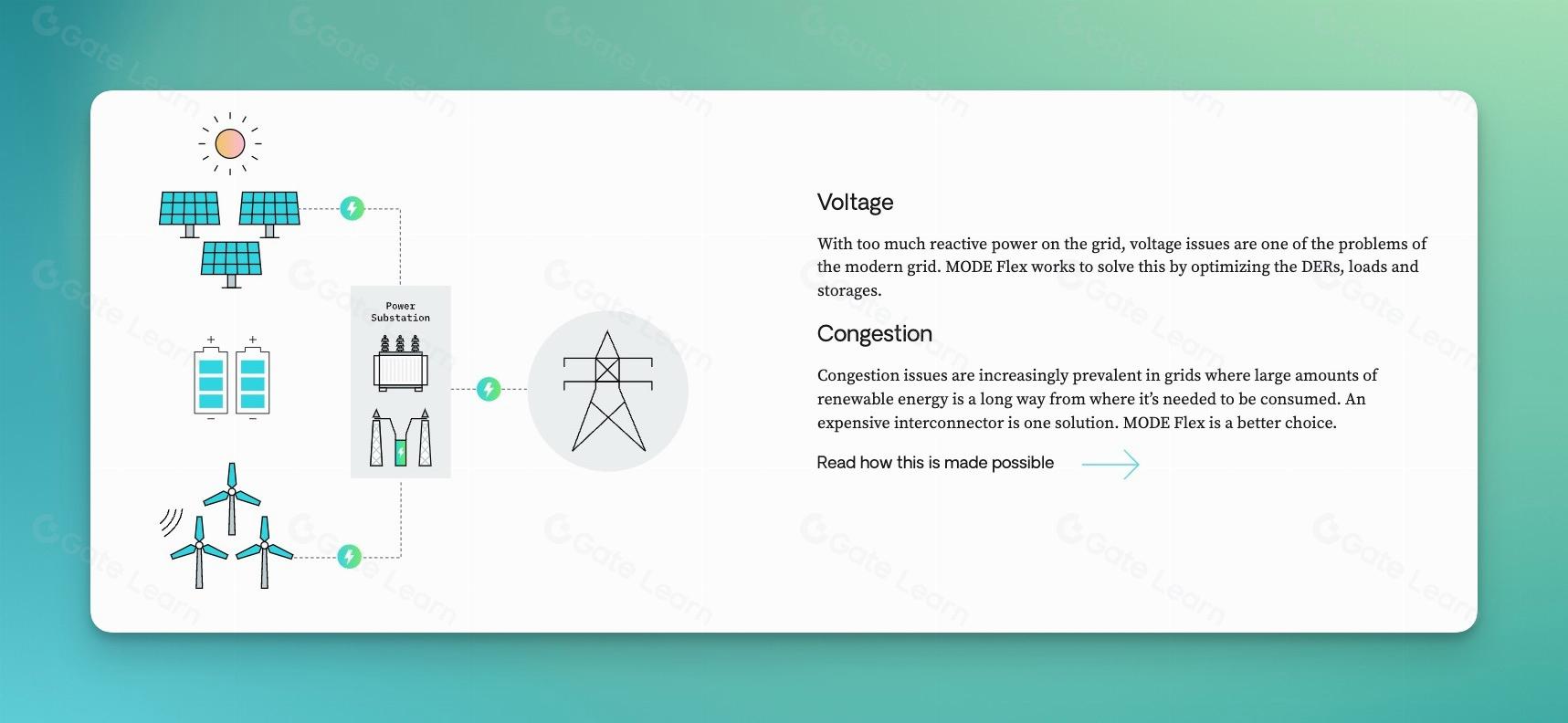Power Ledger、Energy Web Token、Efforce 和 SunContract 概述
在本课中,我们将详细介绍一些真实的应用案例。
Power Ledger
Power Ledger 是一个基于区块链的平台,使本地社区能够在没有传统能源供应商干预的情况下分配和销售多余的电力,从而彻底改变能源的生产和分配。该平台旨在解决能源市场的各种问题,如需要去中心化、分配和管理机制落后、能源价格上涨、促进能源共创和自给等。

Power Ledger 平台的运作方式
Power Ledger 平台在两个区块链上运行:
- 以太坊区块链:支持使用 Power Ledger (POWR) 代币的公共层,可以在全球范围内购买、出售和交易。
- EcoChain:一个私有的联盟链,负责运行该平台的第二个代币 Sparkz。EcoChain可以根据当地法规和特定地区的现有供应水平进行定制。

Power Ledger 的特点
Power Ledger 的生态系统由 POWR 和 Sparkz 这两种代币驱动,它们通过基于以太坊的智能合约进行交互。该平台通过智能电表设备与电网建立通信,智能电表跟踪用电量并将信息传递给能源生产商以进行计费。
POWR 是实用型代币,具有以下几种用途:
- 为应用的开发方和用户提供平台访问权限。
- 通过“绿色能源忠诚度奖励”计划向网络参与者提供忠诚度奖励。
- 促进可再生能源慈善机构之间的合作,并提供参与 Asset Germination Events(处理众筹的可再生能源资产的活动)的机会。
- 通过智能债券技术充当在 Power Ledger 平台上的债券担保。
另一方面,Sparkz 代币是与当地法定货币挂钩的电力信用,用于支付应用开发商提供的服务。Sparkz 代币在需要时创建、使用并在赎回后销毁,确保稳定的兑换比率和顺畅的能源交易体验。
基于区块链的能源交易中 Power Ledger 的真实用例
- xGrid:使拥有过剩电力的能源生产商能够在受监管的电网上将其出售给客户。该平台的区块链机制实现了即时、透明、低成本的交易结算。 xGrid 深受家庭、企业、可再生能源生产商和电力销售商的欢迎,其最终目标是减少电费并提高可再生能源投资的价值。

- uGrid:专注于更实惠的实时电费计量、大数据收集、微电网管理和微交易处理。uGrid 的目标客户群是通过联网电网相连的社区,例如购物中心、公园和公寓大楼,目的是帮助他们更有效地跟踪和管理集体能源使用情况。

- Power Port:专为电动汽车及其充电站设计,提供安全电费计量、透明结算机制、低成本支付、用户 ID 以及与开放式充电点协议 (OCPP) 等现有系统的整合。Power Port 旨在简化电动汽车充电过程,提升用户体验。
Energy Web Token
Energy Web Token (EWT) 是 Energy Web(一个支持能源领域应用开发的开源平台)的原生加密货币,旨在通过连接电网运营商、客户和太阳能电池板、恒温器和电动汽车等实物资产,创建一个可追溯程度更高且更加民主化和低碳化的能源系统。Energy Web 基金会(EWF)成立于2017年,由落基山研究所(Rocky Mountain Institute)、Grid Singularity 及其他十家附属机构共同创办。EWT 在维护和运营 Energy Web 网络中发挥着重要作用,并拥有许多实际应用。

Energy Web 平台的运作方式
Energy Web 区块链结合了许多加密货币的共有特性,如共享基础设施、激励计划和可追踪的信息记录。它的区块链代码源自以太坊,侧重于影响能源行业的功能,而不是重新创建整个基础设施。该平台整合了预言机、跨链桥和数字身份系统等中间件技术,将现实世界的数据连接到Energy Web 应用。
Energy Web 链采用权威证明(PoA)共识机制来保持其分布式网络的同步。在 PoA 中,只有满足特定资格标准的一定数量的节点(即验证节点)才能验证交易并创建区块。验证者因参与维护网络可以获得 EWT 代币作为酬劳。
Energy Web Token 的独特功能
- Energy Web 去中心化操作系统(EW-DOS):开源软件堆栈和标准,旨在成为全球能源领域的数字基础设施。
- 中间件技术:该平台整合了预言机、跨链桥和数字身份系统,为 Energy Web 应用提供顺畅体验。
- 权威证明(PoA)共识机制:工作量证明 (PoW) 的变体,仅允许某些节点(验证节点)验证交易并创建区块。验证者节点必须满足特定的资格标准并可以获得 EWT 代币作为回报。
基于区块链的能源交易中 Energy Web Token 的真实用例
- 交易支付:EWT 可用于交易支付,主要用于支付 Energy Web 链上的 gas 费以及跨链桥和预言机等服务费,采用按需付费的方式。
- 捆绑实用层服务支付:企业可以预付去中心化标识符(DID)的费用,以便在预定的时间内访问相关服务,从而简化去中心化应用的采购流程并提供顺畅的用户体验。
- 激励验证者:Energy Web 根据区块中包含的每笔交易的程序化奖励和费用,用 EWT 奖励验证者,有助于维护网络安全并确保验证者诚实行事。

Energy Web Token 已拥有 100 多个合作伙伴,其中包括 Tepco、Siemens、Shell 和 Exelon 等行业巨头。其广泛的应用和真实用例证明了其通过基于区块链的能源交易彻底改变能源行业的潜力。
Efforce
Efforce 是致力于连接能源效率投资需求和供应的首个区块链平台,拥有众多贡献者。希望提高能源效率的企业可以在平台上登记自己的需求,以吸引投资用。Efforce 团队对需求进行验证,并与该企业合作开发能源效率改进项目。他们会评估所需的投资、年度内部回报率 (IRR),并签署能源绩效合同 (EPC)。这种创新方法使贡献者能够投资这些项目,并获得代表所节省的能源的代币作为回报,以此简化能源效率市场并实现民主化。

Efforce 平台的运作方式
Efforce 平台使公司能够通过与贡献者分享所节省的能源,为其能源再开发项目找到所需的众筹资金。经济实体可以通过所节省能源的代币化直接与消费者或贡献者协商他们的节能收益,保证流动性并扩大获取资本投资的渠道。该平台采用类似于能源服务公司 (E.S.Co) 的模式运作,采用能源绩效合同 (EPC) 从能效项目中产生积极的经济回报。

EPC 有助于将金融投资引入第三方能源系统(如工业厂房或建筑物)的再开发和性能改进项目。这些干预措施所节省的能源价值由进行投资并实施再开发过程的 E.S.Co 和受益人共享。E.S.Co 利用其节省的能源份额来获得投资回报,受益人也能降低其能源开支。安全且去中心化的区块链系统保证了节能数据的完整性和唯一性,数据由区块链本身进行验证和认证。
Efforce 的特点
Efforce 实现了所节省能源的代币化,创建了一个由区块链支持的具有流动性、透明性和可访问性的市场,是能源效率市场中一个独特的存在。代币化代表了希望提高流程效率的公司与社区之间的一种合同机制。欧洲监管机构已将这种创新的代币化模式归类为奖励型众筹,贡献者将获得免费的节能奖励,他们可以保留、出售或用来抵消自己的能源消耗。

Efforce 利用区块链技术解决了传统系统中进入能效市场所需的门槛问题,如高昂的初始成本、要求一定的技术知识、投资者和项目方之间缺乏信任和会面场所、难以评估潜在节能、金融机构的技术知识有限以及投资回报期的不确定性,从而使能效市场变得简单、易于访问且透明。通过这种方式,Efforce 支持世界银行到 2030 年将整体能源效率提高一倍的目标。
基于区块链的能源交易中 Efforce 的真实用例
Efforce 已成功应用于各个行业,使企业能够在不使用股权的情况下为其建筑物或工业过程的能源效率改进提供资金。贡献者可以投资能源绩效智能合约,并积累从能效改进项目中获得的节能。这些节省下来的能源可用于降低消耗、出售给其他消费者或抵消能源成本,从而创建可持续且高效的能源市场。
一个著名的例子是 AitherCO2,该公司使用 EPC 资助一家意大利包机运营商机队中的 20 架飞机安装混合式翼尖。这些翼尖通过减少诱导阻力和燃油消耗来提高飞机性能,与没有翼尖的飞机相比,Jet A1 燃油消耗减少了 8%。该能效项目产生了良好的节能效果,在 EPC 合同的前两年内节省了 2.2 亿美元,同时还减少了 230 万吨二氧化碳排放,为环境做出了贡献。

Efforce 代币持有者可以访问平台上的节能项目,为全球范围内能源效率的推广做贡献。节省的能源成为代币持有者手中的有形资产,他们可能决定出售这些能源或用它们来抵消电费。此外,在通过能源绩效智能合约获得和认证的节能中,1% 会捐赠并分配给所有 Efforce 贡献者,从而增加他们代币的价值。
Efforce 平台通过以透明且可访问的方式将企业、投资者和消费者连接起来,展示了区块链技术在彻底改变能源效率市场方面的潜力。其独特的功能和现实世界的用例体现了基于区块链的能源交易的优势,并展示出它在推动可持续发展和提高全球能源效率方面的潜力。

SunContract
SunContract 是一个创新项目,汇集了三个关键领域的巨大潜力:电力、区块链技术和人员。其目标是开发一种创新的能源交易模式,不仅可以改变我们生产和消费电力的方式,还能为我们的星球创造一个更干净、更加可持续的未来。支持 SunContract 就是为实现可持续愿景做出贡献,将能源生产商和消费者团结起来,实现共同目标:降低成本并建立去中心化、智能且环保的能源格局。

SunContract 平台的运作方式

SunContract 的特点
SunContract 将区块链技术和可再生能源结合起来,创建了一种独特的、颠覆性的能源交易模式。总的来说,该平台具有以下几大特征:
- 信任:SunContract 的区块链技术消除了第三方监督能源交易的需要。智能合约的使用让所有参与者都信任该技术,确保交易安全可靠。
- 透明度:平台上的所有交易都是公开且不可篡改的,为能源生产商和消费者营造健康的商业环境。
- 可追溯性:区块链上的每一笔交易都可以追溯到原始地址,确保用户隐私和安全。
- 时间戳:每笔交易都包含一个时间戳,使用户能够验证交易执行的确切时刻。
- 交易:基于区块链的交易是可信、透明、可追溯的,且都带有时间戳,比传统交易方式更高效、更具成本优势。
此外,通过区块链技术实现的可再生太阳能的好处:
- 数字化:SunContract 对电力交易的数字化使其更加灵活、透明和可追溯。
- 脱碳化:SunContract 加速了向可再生能源的过渡,有助于实现温室气体排放目标。
- 去监管化:SunContract 鼓励支持可再生能源和自我可持续发展的政府政策,促进能源领域的公平竞争环境。
- 去中心化:SunContract 重新分配中央机构的权力,使个人能够为自己和社区带来改变。
- 民主化:SunContract 促进了获取电力的能力,允许用户选择自己喜欢的能源来源,从而促进跨多个市场的分布式发电。
SunContract 的创新模式结合了区块链技术和可再生能源的优势,创造了旨在变革能源市场的突破性服务。该平台的重点是 SunContract 能源池,这是实现其点对点能源交易长期目标的第一步,同时也是最关键的一步。独立太阳能发电商可以加入 SunContract 能源池,为相连的消费者提供清洁能源。
基于区块链的能源交易中 SunContract 的真实用例
SunContract 的创新平台利用区块链技术和可再生能源为生产者和消费者提供顺畅的能源交易体验。具体来说,该平台的运作方式包含以下方面:
- 加入平台:可再生能源(尤其是太阳能)生产商以及对使用清洁能源感兴趣的消费者可以加入 SunContract 能源池。通过参与该池,独立太阳能发电商可以为相连的电力消费者提供清洁能源。
- 智能合约:SunContract 利用智能合约实现生产者和消费者之间安全可靠的能源交易。智能合约使整个流程自动化,确保了透明性并消除了第三方监督的需要。
- 交易透明:平台上的所有能源交易都记录在区块链上,为所有参与方提供完全透明的交易记录,确保交易不可更改且可追溯,从而营造健康公平的商业环境。
- 点对点能源交易:SunContract 的长期目标是建立一个点对点能源交易平台。SunContract 能源池为这一愿景奠定了基础,允许能源生产商和消费者直接交易能源,无需中介。
- 赋予用户权力:SunContract 将中央机构的权利重新分配,将控制权交还给个人,实现了去中心化。因此,用户能够更明智地决定其能源消费和生产,从而推动能源供应的民主化。
- 政府政策和法规:SunContract 积极支持和鼓励促进可再生能源创新和投资的政府政策。通过促进能源行业的公平竞争环境,SunContract 有助于发挥太阳能和其他可再生能源的潜力。
- 环境可持续发展:通过推广可再生能源和加速脱碳过程,SunContract 平台为实现全球温室气体排放目标作出贡献,推动实现一个更清洁、更可持续的未来。

SunContract 平台结合了区块链技术和可再生能源的优势,创造了一种具有颠覆性的能源交易模式。通过专注于 SunContract 能源池并致力于打造 P2P 能源交易平台,该公司旨在彻底改变能源市场,并使个人能够掌控自己的能源需求。
结语
通过本课程所介绍的内容,我们可以清楚地看到区块链技术在提高效率、透明度和安全性并彻底改变能源交易领域方面的潜力。在第一课中,我们探讨了传统能源交易系统面临的挑战以及区块链技术提供的去中心化解决方案。第二课探讨了基于区块链的能源交易的各种用例,包括点对点和社区交易,并介绍了现实的成功项目。在最后一课中,我们探讨了 Power Ledger、Energy Web、Efforce 和 SunContract 平台,分析了它们的独特特征和实际应用。
基于区块链的能源交易可能改变我们生产和消费能源的方式,赋予消费者更大的控制权和选择权,同时促进可再生能源发电。尽管性能和可扩展性等挑战仍然存在,但区块链技术在能源领域的应用似乎有着光明的前景。随着行业的不断发展,基于区块链的能源交易领域一定会涌现新的创新和发展,让我们拭目以待。





